《分子生物学》课程教学课件(PPT讲稿)Chaptor 6 The biosynthesis of protein(translation)
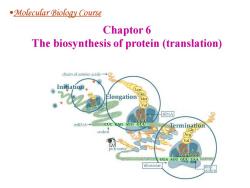
Molecular Biology course Chaptor 6 The biosynthesis of protein (translation) chain of amino acids- Initiation Elongation (Mer Val mRNA CUC EAG AUG GUU Termination Val CGAISTOP GGA AGG GUU LAA nbosome stop codon
•Molecular Biology Course Chaptor 6 The biosynthesis of protein (translation)
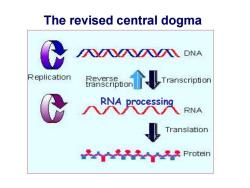
The revised central dogma 八NN入八 DNA Replication Transcripti on RNA Translation Protein
The revised central dogma RNA processing
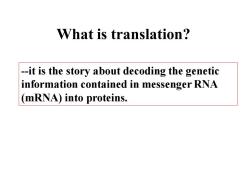
What is translation? -it is the story about decoding the genetic information contained in messenger RNA (mRNA)into proteins
What is translation? -it is the story about decoding the genetic information contained in messenger RNA (mRNA) into proteins
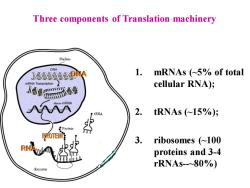
Three components of Translation machinery Nucleus DNA 1.mRNAs (5%of total RNA Transcription cellular RNA); 2.tRNAs(~15%) Protein PROTEIN 3. ribosomes (~100 RN proteins and 3-4 rRNAS-80%) ribosome
Three components of Translation machinery 1. mRNAs (~5% of total cellular RNA); 2. tRNAs (~15%); 3. ribosomes (~100 proteins and 3-4 rRNAs-~80%)

Translation costs extremely In rapid growing bacterial cells,protein synthesis consumes: 80%of the cell's energy; 50%of the cell's dry weight; Why?
Translation costs extremely In rapid growing bacterial cells, protein synthesis consumes: • 80% of the cell’s energy; • 50% of the cell’s dry weight; Why?

The main challenges of translation The genetic information in mRNA cannot be recognized directly by amino acids; 。 The genetic code has to be recognized by an adaptor(适配器)molecule(translator),and this adaptor recruit the corresponding amino acid accurately;
The main challenges of translation • The genetic information in mRNA cannot be recognized directly by amino acids; • The genetic code has to be recognized by an adaptor(适配器 ) molecule (translator), and this adaptor recruit the corresponding amino acid accurately;
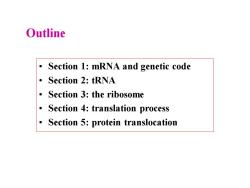
Outline Section 1:mRNA and genetic code Section 2:tRNA Section 3:the ribosome 。 Section 4:translation process Section 5:protein translocation
Outline • Section 1: mRNA and genetic code • Section 2: tRNA • Section 3: the ribosome • Section 4: translation process • Section 5: protein translocation
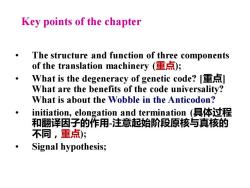
Key points of the chapter The structure and function of three components of the translation machinery(重点); What is the degeneracy of genetic code?I重点] What are the benefits of the code universality? What is about the Wobble in the Anticodon? ● initiation,elongation and termination(具体过程 和翻译因子的作用-注意起始阶段原核与真核的 不同,重点; Signal hypothesis;
Key points of the chapter • The structure and function of three components of the translation machinery (重点); • What is the degeneracy of genetic code? [重点] What are the benefits of the code universality? What is about the Wobble in the Anticodon? • initiation, elongation and termination (具体过程 和翻译因子的作用-注意起始阶段原核与真核的 不同,重点); • Signal hypothesis;
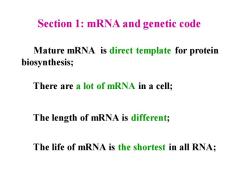
Section 1:mRNA and genetic code Mature mRNA is direct template for protein biosynthesis; There are a lot of mRNA in a cell; The length of mRNA is different; The life of mRNA is the shortest in all RNA;
Mature mRNA is direct template for protein biosynthesis; There are a lot of mRNA in a cell; The length of mRNA is different; The life of mRNA is the shortest in all RNA; Section 1: mRNA and genetic code
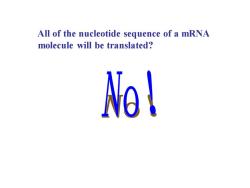
All of the nucleotide sequence of a mRNA molecule will be translated? Nel
All of the nucleotide sequence of a mRNA molecule will be translated?
按次数下载不扣除下载券;
注册用户24小时内重复下载只扣除一次;
顺序:VIP每日次数-->可用次数-->下载券;
- 《分子生物学》课程教学课件(PPT讲稿)Chapter 2 Structure of Genome.ppt
- 《分子生物学》课程教学课件(PPT讲稿)Chapter 1 Introduction of Molecular Biology.ppt
- 《分子生物学》课程教学课件(PPT讲稿)Chapter 3 DNA replication.ppt
- 《分子生物学》课程教学课件(PPT讲稿)Chapter 4 DNA damage and repair.ppt
- 《分子生物学》课程教学课件(PPT讲稿)Chapter 8 The Hot Topics in Genomics and Post-Genome Era.ppt
- 《分子生物学》课程教学课件(PPT讲稿)Chapter 7 The Control of Gene Expression.ppt
- 《分子生物学》课程教学课件(PPT讲稿)Chapter 9 Principles and Techniques of Gene Engineering.ppt
- 《分子生物学》课程教学课件(PPT讲稿)Chapter 5 Biosynthesis of RNA.ppt
- 《分子生物学》课程教学课件(PPT讲稿)Chapter 6 The Biosynthesis of Protein(Translation).ppt
- 《分子生物学》课程教学课件(PPT讲稿)Chapter 3 DNA replication.ppt
- 《分子生物学》课程教学课件(PPT讲稿)Chapter 1 Introduction of Molecular Biology.ppt
- 《分子生物学》课程教学课件(PPT讲稿)Chapter 2 Structure of Genome.ppt
- 《分子生物学》课程教学课件(PPT讲稿)Chapter 4 DNA Damage and Repair.ppt
- 内蒙古农业大学:《分子生物学》课程教学资源(自编教材)分子生物学实验技术指导.pdf
- 内蒙古农业大学:《分子生物学》课程教学资源(自编教材)英文版分子生物学.pdf
- 内蒙古农业大学:《分子生物学》课程教学资源(自编教材)英文版生物化学.pdf
- 内蒙古农业大学:《分子生物学》课程教学实验指导(共六个实验).pdf
- 内蒙古农业大学:《分子生物学》课程教学资源(授课教案).pdf
- 内蒙古农业大学:《分子生物学》课程教学大纲(负责人:李国婧).pdf
- 安徽大学:《基因工程》课程授课教案(讲义,共八章).docx
- 《分子生物学》课程教学课件(PPT讲稿)Chapter 5 Biosynthesis of RNA.ppt
- 《分子生物学》课程教学课件(PPT讲稿)Chapter 8 the hot topics in genomics and Post-Genome Era.ppt
- 《分子生物学》课程教学课件(PPT讲稿)Chapter 7 the control of gene expression.ppt
- 内蒙古科技大学:《微生物学》课程教学大纲 Microbiology A(负责人:马利兵).doc
- 内蒙古科技大学:《微生物学》课程授课教案(讲义,共十一章).pdf
- 内蒙古科技大学:《微生物学》课程教学资源(实验指导,共十七个实验).pdf
- 内蒙古科技大学:《微生物学》课程各章课后习题(含参考答案).doc
- 《微生物学》课程教学课件(PPT讲稿)09 微生物生态.ppt
- 《微生物学》课程教学课件(PPT讲稿)01 绪论.ppt
- 《微生物学》课程教学课件(PPT讲稿)02 显微与纯培养 第一节 微生物的分离和纯培养.ppt
- 《微生物学》课程教学课件(PPT讲稿)02 显微与纯培养 第二节 显微镜和显微技术.ppt
- 《微生物学》课程教学课件(PPT讲稿)03 微生物的结构与功能(1/3).ppt
- 《微生物学》课程教学课件(PPT讲稿)03 微生物的结构与功能(2/3).ppt
- 《微生物学》课程教学课件(PPT讲稿)03 微生物的结构与功能(3/3).ppt
- 《微生物学》课程教学课件(PPT讲稿)04 病毒 第一节 概述.ppt
- 《微生物学》课程教学课件(PPT讲稿)04 病毒 第二节 毒粒的性质.ppt
- 《微生物学》课程教学课件(PPT讲稿)04 病毒 第三节 病毒的复制.ppt
- 《微生物学》课程教学课件(PPT讲稿)04 病毒 第四节 病毒的非增殖性感染.ppt
- 《微生物学》课程教学课件(PPT讲稿)05 微生物的营养(培养基).ppt
- 《微生物学》课程教学课件(PPT讲稿)06 微生物的代谢(1/2).ppt
